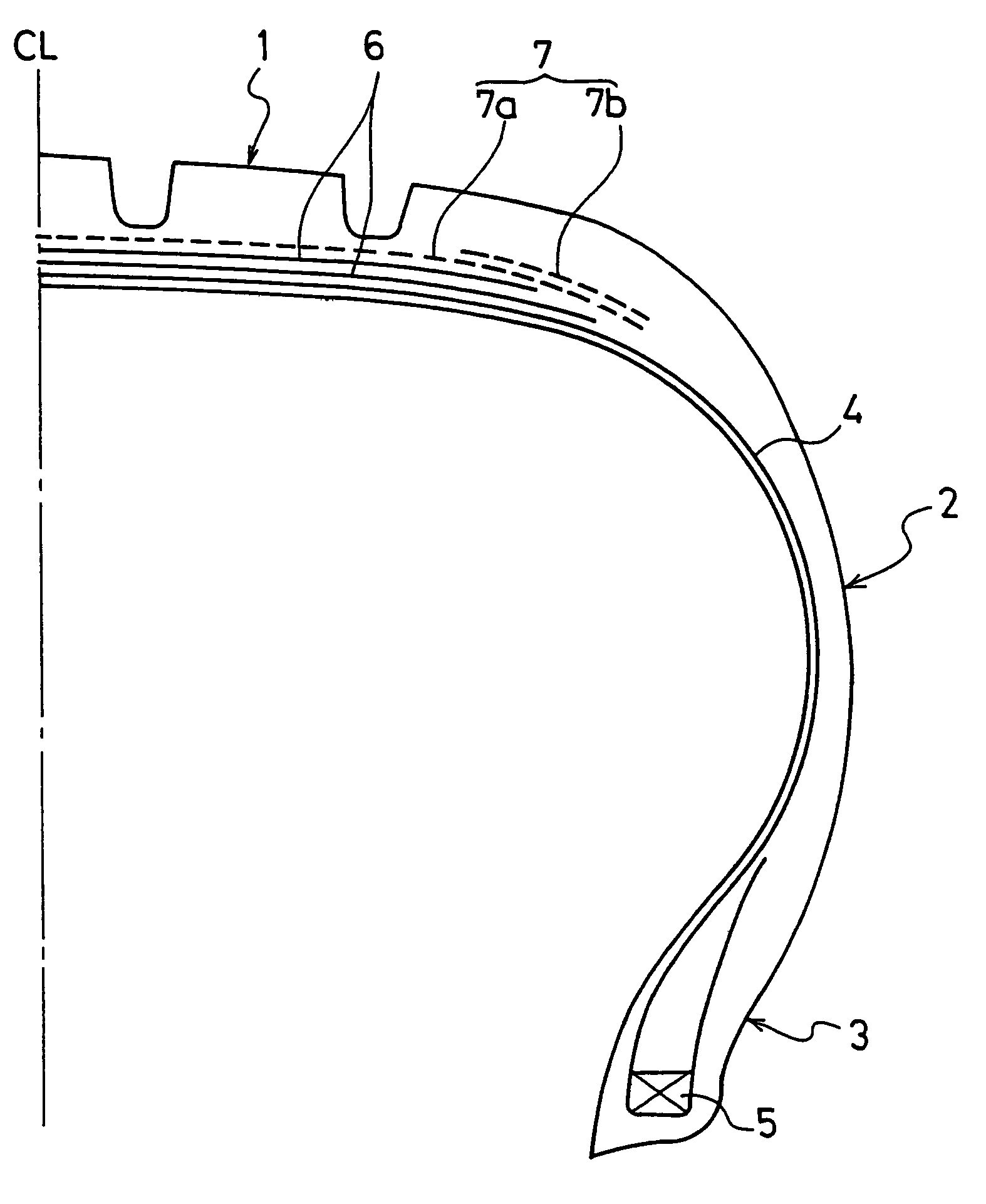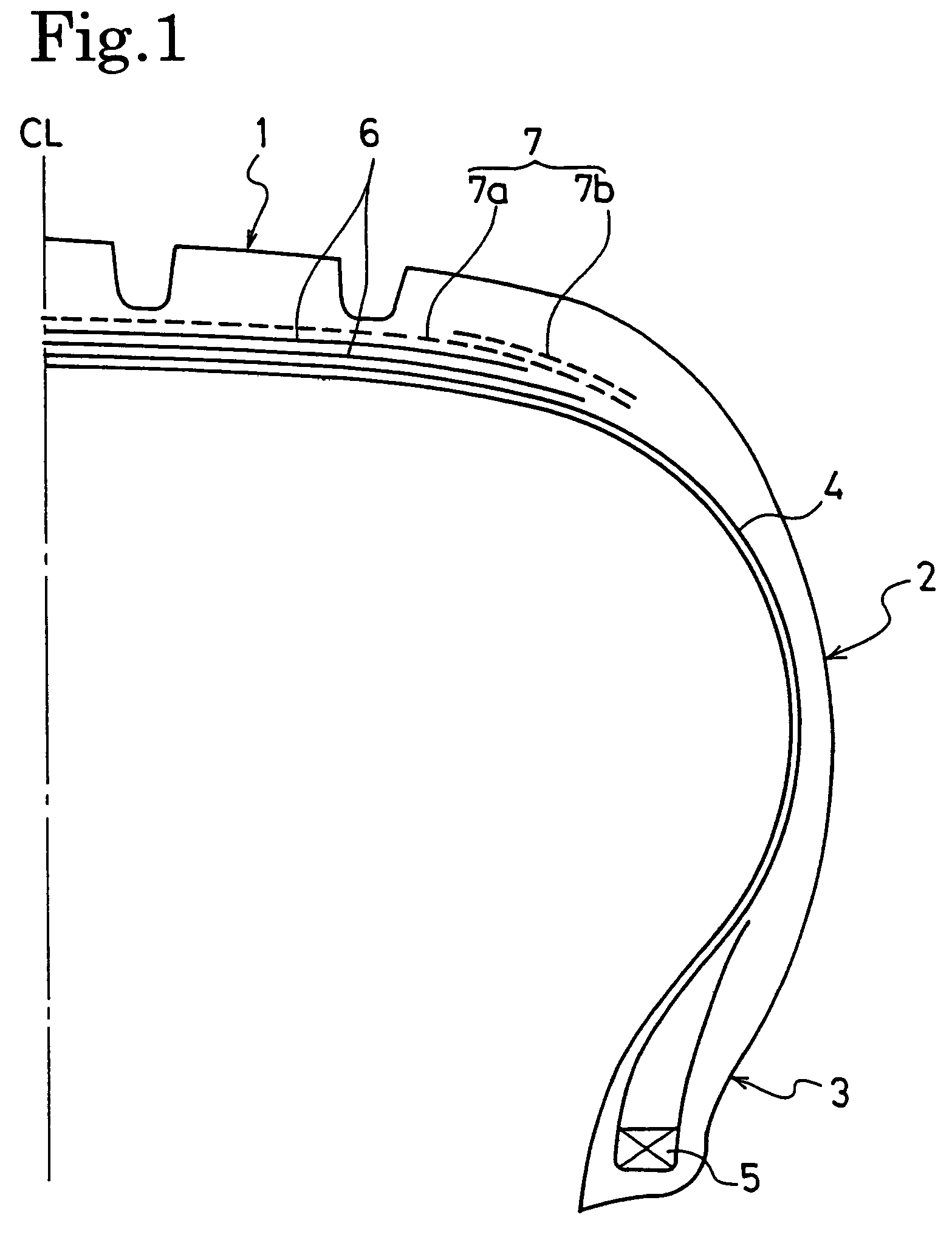Rubber reinforcing fiber cord, method of manufacturing the same, and radial pneumatic tire for passenger car using the same
a technology of fiber reinforced cords and radial pneumatic tires, which is applied in the direction of transportation and packaging, rubber layered products, ceramic layered products, etc., can solve the problems of destroying the global environment, unable to find an example of silk strings in automobile tires which bear a considerable load, and achieve excellent road noise reduction effect, excellent high-speed durability, and favorable driving stability.
- Summary
- Abstract
- Description
- Claims
- Application Information
AI Technical Summary
Benefits of technology
Problems solved by technology
Method used
Image
Examples
examples 4 to 8
[0085]There were prepared five kinds of rubber reinforcing fiber cord different from Example 1 in that, in the RFL liquid mixtures, only F / R molar ratios thereof were set differently to 1.5, 2.0, 3.0, 3.5 and 4.0 as described in Table 4 while RFL solids content concentrations thereof were uniformly set equal to 20% of Example 1. Other than the above difference, they were prepared through the covering treatments under the same condition as that of Example 1 (to be Examples 4 to 8).
[0086]Results obtained through the same physical property measurement as described in Table 2 with respect to these respective rubber reinforcing fiber cords are shown in Table 5.
[0087]From Table 5, it can be found that, when the F / R molar ratio of the RFL adhesive agent is less than 2.0, the post-moisture-absorption strength retention rate and the high-temperature strength retention rate decrease. On the other hand, it can be found that, when the F / R molar ratio exceeds 3.5, the initial tensile strength, t...
examples 9 to 13
[0090]There were prepared five kinds of rubber reinforcing fiber cord different from Example 1 in that, in the RFL liquid mixtures, only RF / L solids content weight ratios thereof were set differently to 0.15, 0.2, 0.25, 0.35 and 0.4 as described in Table 6 while RFL solids content concentrations and F / R molar ratios thereof were uniformly set equal respectively to 20% and 2.5 as in Example 1. Other than the above difference, they were prepared through the covering treatments under the same condition as Example 1 (to be Examples 9 to 13).
[0091]Results obtained through the same physical property measurement as described in Table 2 with respect to these respective rubber reinforcing fiber cords are shown in Table 7.
[0092]From Table 7, it can be found that, when the RF / L solids content weight ratio of the RFL adhesive agent is less than 0.2, the post-moisture-absorption strength retention rate and the high-temperature strength retention rate, and the water resistant adhesion strength de...
examples 14 to 16
[0095]There were prepared another three kinds of rubber reinforcing fiber cord different from Example 1 only in that, in the RFL liquid mixtures, a blocked isocyanate 40% water dispersion obtained by blocking an isocyanate terminal of methyl diisocyanate (MDI) by use of methyl ethyl keto oxime is added as an isocyanate derivative in order that solids contents of the blocked isocyanate can be 15 weight parts, 30 weight parts, and 50 weight parts, respectively, with respect to 100 weight parts of the RFL solids contents thereof. Other than the above difference, they were prepared through the covering treatments under the same condition as Example 1.
[0096]Results obtained through the same physical property measurement as described in Table 2 with respect to these respective rubber reinforcing fiber cords are shown in Table 9.
[0097]From Table 9, it can be found that the compounding of the isocyanate derivative in the adhesive agent leads to remarkable enhancement in water resistant adhe...
PUM
| Property | Measurement | Unit |
|---|---|---|
| molar ratio | aaaaa | aaaaa |
| temperature | aaaaa | aaaaa |
| temperature | aaaaa | aaaaa |
Abstract
Description
Claims
Application Information
 Login to View More
Login to View More - R&D
- Intellectual Property
- Life Sciences
- Materials
- Tech Scout
- Unparalleled Data Quality
- Higher Quality Content
- 60% Fewer Hallucinations
Browse by: Latest US Patents, China's latest patents, Technical Efficacy Thesaurus, Application Domain, Technology Topic, Popular Technical Reports.
© 2025 PatSnap. All rights reserved.Legal|Privacy policy|Modern Slavery Act Transparency Statement|Sitemap|About US| Contact US: help@patsnap.com



